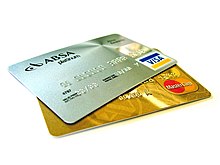This article has multiple issues. Please help improve it or discuss these issues on the talk page. (Learn how and when to remove these messages)
|

| Part of a series on financial services |
| Banking |
|---|
 |

A credit card is a payment card, usually issued by a bank, allowing its users to purchase goods or services, or withdraw cash, on credit. Using the card thus accrues debt that has to be repaid later.[1] Credit cards are one of the most widely used forms of payment across the world.[2]
A regular credit card is different from a charge card, which requires the balance to be repaid in full each month, or at the end of each statement cycle.[3] In contrast, credit cards allow consumers to build a continuing balance of debt, subject to interest being charged at a specific rate. A credit card also differs from a charge card in that a credit card typically involves a third-party entity that pays the seller, and is reimbursed by the buyer, whereas a charge card simply defers payment by the buyer until a later date.[citation needed] A credit card also differs from a debit card, which can be used like currency by the owner of the card.
As of June 2018,[update] there were 7.753 billion credit cards in the world.[4] In 2020, there were 1.09 billion credit cards in circulation in the United States, and 72.5% of adults (187.3 million) in the country had at least one credit card.[5][6][7][8]
- ^ O'Sullivan, Arthur; Sheffrin, Steven M. (2003). Economics: Principles in action (Textbook). Upper Saddle River, New Jersey: Pearson Prentice Hall. p. 261. ISBN 0-13-063085-3.
- ^ The World Bank. "Credit card ownership (% age 15+)". World Bank Gender Data Portal. Retrieved 21 October 2023.
- ^ Schneider, Gary (2010). Electronic Commerce. Cambridge: Course Technology. p. 497. ISBN 978-0-538-46924-1.
- ^ "Payment Cards in Circulation Worldwide" (PDF). Nilson Report. October 2018. Archived from the original (PDF) on 3 November 2022. Retrieved 24 October 2022.
- ^ "Charts & Graphs Archive". Nilson Report. Archived from the original on 12 May 2023. Retrieved 24 October 2022.
- ^ "Payment Cards in the U.S. Projected". Nilson Report. Archived from the original on 24 October 2022. Retrieved 24 October 2022.
- ^ Gabrielle, Natasha (19 April 2022). "Credit and Debit Card Market Share by Network and Issuer". fool.com. Retrieved 24 October 2022.
- ^ "The Nilson Report" (PDF). October 2019. Archived from the original (PDF) on 26 January 2021. Retrieved 13 October 2021.